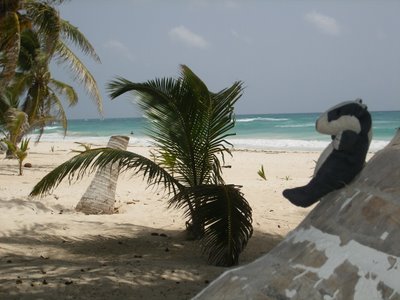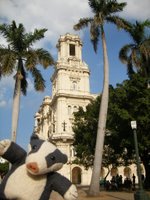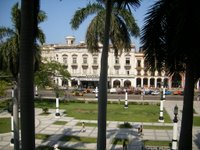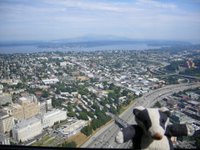¡Arrrrriba Mexico!
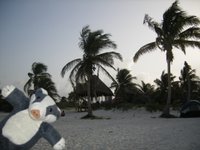 After the somewhat materially spartan surroundings of Cuba, it was nice to return to Mexico and the relatively comfy high-life of the Yucatan Peninsula. It comes as no surprise that this part of the world should be rich in creature comforts, as the area is the playground of American tourists on their annual 7-day vacation, or college students on a beach 'n' booze break. Unfortunately these facts push the price of everything up to inflated levels by Mexican standards, as those types of visitor tend to have lots of money and little time rather than the other way around.
After the somewhat materially spartan surroundings of Cuba, it was nice to return to Mexico and the relatively comfy high-life of the Yucatan Peninsula. It comes as no surprise that this part of the world should be rich in creature comforts, as the area is the playground of American tourists on their annual 7-day vacation, or college students on a beach 'n' booze break. Unfortunately these facts push the price of everything up to inflated levels by Mexican standards, as those types of visitor tend to have lots of money and little time rather than the other way around.The worst place for that kind of thing is Cancun, so after landing there I moved on straight away to Isla Mujeres, a small island not far off the coast. Isla Mujeres is still expensive and totally "Gringo", but is much more laid-back
 than many other places in the area. It has a very cool hostel which is right next to a great beach, where the crystal-clear Pacific was actually too warm to stay in for very long! Having grown up taking holidays at beaches around the UK, I never thought I'd hear myself say that.
than many other places in the area. It has a very cool hostel which is right next to a great beach, where the crystal-clear Pacific was actually too warm to stay in for very long! Having grown up taking holidays at beaches around the UK, I never thought I'd hear myself say that.The hostel was a very sociable place, and I enjoyed a few games of beach volleyball with an international crowd made up chiefly of ridiculously over-competitive Israelis blokes split across both teams. Imagine a John McEnroe style argument in Hebrew every time there was the slightest doubt as to whether the ball was in or out, while everyone else sat down and rested until they were quite done...
 At the hostel I met Swiss Christian and Christina, and the next day we all set off southwards for Tulum further down the coast. Mr. Dasje had definitely made another friend in Christina, so he got lots of outings for photo opportunities over the time that we travelled with them. Tulum was a nice place to spend a few days.
At the hostel I met Swiss Christian and Christina, and the next day we all set off southwards for Tulum further down the coast. Mr. Dasje had definitely made another friend in Christina, so he got lots of outings for photo opportunities over the time that we travelled with them. Tulum was a nice place to spend a few days. We took an overpriced beachfront chalet and spent a few days chilling, eating, drinking, diving and sitting on the beach.
We took an overpriced beachfront chalet and spent a few days chilling, eating, drinking, diving and sitting on the beach.The diving was different to everything I had done before, as we dived in cenotes rather than the ocean. Cenotes are underground systems of caves and caverns which are filled, usually floor to ceiling, with fresh water. So unlike
 ocean diving, there was usually no natural light (except for the occasional shaft from a vent), and we used torches. It was a great couple of dives; the underground volcanic terrain was pretty stunning.
ocean diving, there was usually no natural light (except for the occasional shaft from a vent), and we used torches. It was a great couple of dives; the underground volcanic terrain was pretty stunning.Then Christian and Christine left Tulum on a tortuous bus journey going the long way to Guatemala. Apparently if you are Swiss you can't go the easy way through
 Belize, unless you have a very expensive visa. I wonder what the Swiss ever did to Belize.... Anyway, I visited the ruins on my own and was not particularly overwhelmed. They are nice enough, just on the global scale of things no great shakes, although they do go right down to a great beach! Maybe those Mayan town planners were up for a little surfing, who knows.
Belize, unless you have a very expensive visa. I wonder what the Swiss ever did to Belize.... Anyway, I visited the ruins on my own and was not particularly overwhelmed. They are nice enough, just on the global scale of things no great shakes, although they do go right down to a great beach! Maybe those Mayan town planners were up for a little surfing, who knows.From Tulum I moved inland to a place with some proper Mayan ruins; Chichen Itza. Now they were more like it. I got to the area
 the night before in order to be at the site at 8 am, hopefully beating the tour bus crowds. It was worth the effort. I enjoyed a site virtually empty of other people for the first couple of hours, (other than the ubiquitous sellers of crafty souvenirs who apparently aren't supposed to be there, but most certainly are). The ruins are in various states of conservation or decay, but are
the night before in order to be at the site at 8 am, hopefully beating the tour bus crowds. It was worth the effort. I enjoyed a site virtually empty of other people for the first couple of hours, (other than the ubiquitous sellers of crafty souvenirs who apparently aren't supposed to be there, but most certainly are). The ruins are in various states of conservation or decay, but are all very impressive. Especially grand were the main pyramid and the big court where the Mayans played their "life or death" ball game, (the captain of the winning team would lose his head to attain the great honour of meeting the gods!). The only bummer was that you could no longer climb the main pyramid; I suppose they have to balance access with conservation. Also in the area, and right
all very impressive. Especially grand were the main pyramid and the big court where the Mayans played their "life or death" ball game, (the captain of the winning team would lose his head to attain the great honour of meeting the gods!). The only bummer was that you could no longer climb the main pyramid; I suppose they have to balance access with conservation. Also in the area, and right  across the road from my hotel, was a deep cenote which was open to the sky and very popular with locals for swimming.
across the road from my hotel, was a deep cenote which was open to the sky and very popular with locals for swimming.I then moved back to the coast, and visited the island of Cozumel where I did a couple of dives. The island has an excellent reputation and the dives were good; it was a shame the boat we dived off wasn't very comfortable, being nothing more than a little motor launch. That's not what you pay your US$70 for! Where were my snacks and the on-board toilet?!? The island of Cozumel itself is a little weird. It is one of the stops on the itinerary of some of the unfeasibly gargantuan cruise ships that sail the Caribbean, and the whole place seemed to revolve around them. They
 would dock in the morning, belch their load of loaded passengers onto the island to bumble around for a couple of hours, eating in over-priced waterfront restaurants and souvenir shopping, before being sucked back into the belly of the boat again. This meant that the rest of the time the island seemed strangely deserted, with way too many shops and restaurants for the number of people normally there.
would dock in the morning, belch their load of loaded passengers onto the island to bumble around for a couple of hours, eating in over-priced waterfront restaurants and souvenir shopping, before being sucked back into the belly of the boat again. This meant that the rest of the time the island seemed strangely deserted, with way too many shops and restaurants for the number of people normally there.It also meant that local expectations of the visitors were altered. For example, instead of the custom for restaurant tipping prevalent in the rest of Mexico (10% or spare change), in Cozumel waiting staff would expect the American custom of tipping, (15-20%), to prevail, and often this would just be added on to the bill. This was because the ship loads of visitors would tend to just blindly import their own culture rather than abide by local customs.
I left Cozumel and headed for Playa del Carmen, further back up the coast and on the way back towards Cancun, where I eventually had to catch my next flight. Several people had described "Playa" to me as kind of like Cancun,
 just not so bad. The town was clearly constructed around raking in the Gringo Dollar, but I did actually quite like it and had a few fun days there, getting a couple more dives in (from a much more professional boat!). There was another cool hostel there where I met Danish Helle, who had been getting some dives in too before returning to Copenhagen to her medical studies. Helle is a big fan of the BBC Big Band, which I suspect makes her unique amongst the under 40's...
just not so bad. The town was clearly constructed around raking in the Gringo Dollar, but I did actually quite like it and had a few fun days there, getting a couple more dives in (from a much more professional boat!). There was another cool hostel there where I met Danish Helle, who had been getting some dives in too before returning to Copenhagen to her medical studies. Helle is a big fan of the BBC Big Band, which I suspect makes her unique amongst the under 40's... So on my last day in Mexico, I boarded the bus in Playa del Carmen to head back up to the airport and on to Costa Rica. Yet another early morning bus departure had me snoozing in my seat when there was a huge bang, the windscreen shattered and the bus swerved violently to the left. When we had stopped safely at the side of the highway, it became apparent that a car had struck the bus on a front corner, and had then itself ended
So on my last day in Mexico, I boarded the bus in Playa del Carmen to head back up to the airport and on to Costa Rica. Yet another early morning bus departure had me snoozing in my seat when there was a huge bang, the windscreen shattered and the bus swerved violently to the left. When we had stopped safely at the side of the highway, it became apparent that a car had struck the bus on a front corner, and had then itself ended up off the road on the other side of the carriageway. It seems that the car was joining the highway when it hit the bus. The occupants were out and walking around, but were clearly in shock and the bus crew were over getting them to sit down and stay still, soon after which ambulances and police arrived. No one on the bus was hurt, and eventually another bus arrived and took us all on to the airport.
up off the road on the other side of the carriageway. It seems that the car was joining the highway when it hit the bus. The occupants were out and walking around, but were clearly in shock and the bus crew were over getting them to sit down and stay still, soon after which ambulances and police arrived. No one on the bus was hurt, and eventually another bus arrived and took us all on to the airport.So my time in Mexico had been good, although I left very aware of the fact that in many ways the Yucatan peninsula is not typical of Mexico. Or perhaps the region is just a particular face of Mexico.... the face it likes to show its big neighbour to the north in holiday brochures!
